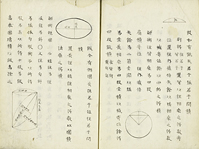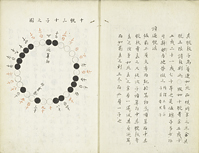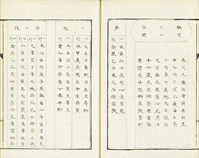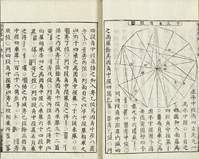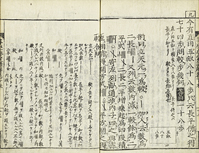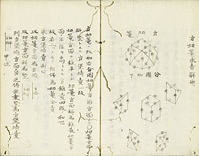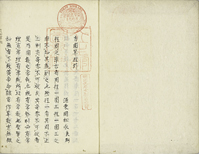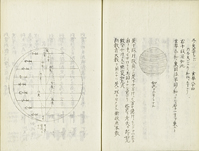2. Seki Takakazu & the Seki School
This exhibition introduces books written by Seki Takakazu (?-1708), who introduced methodological innovation into the mathematics of the Edo period; reproduced Chinese mathematical books that provided the basis to Seki's mathematics; and mathematical books written by the generation that directly inherited the results of his mathematics.
Books Written by Seki Takakazu
1 Kaikendai
Ed. by Seki Takakazu. Ms. 1 v. <140-203>
This book was regarded as an important Wasan book among students of the Seki school, and is also called Kaiken dai no ho, or one of the "Sanbu sho," the collective name for the three books, which are regarded as being among his major accomplishments. (The other two books are Kaiin dai no ho and Kaifuku dai no ho.)
The book consists of descriptions of methods by which the areas of various plane figures and the volumes of several solid figures can be found. Most of the figures are fairly introductory, but one problem dealing with a curved line called "Wanse," similar to a spiral, is exceptionally difficult.
2 Sandatsu no ho
Ed. by Seki Takakazu. Ms. 1 v. <140-204>
3 Sandatsu kenpu
Ed. by Seki Takakazu. Ms. 1 v. <244-76>
This Wasan book was regarded as an important title of the "Shichibusho" among students of the Seki school. The book consists of two chapters: "Sandatsu no ho" and "Kenpu no ho," which are regarded as mathematical recreations.
The first half of the book, "Sandatsu no ho," illustrates a generalized mathematical recreation of a Josephus problem, which is dealt with in Jinkoki. The second half, "Kenpu no ho", generalizes a mathematical recreation, which is also introduced as "shosei metsukeji" (a game involving deducing a character selected by one's opponent) in Jinkoki. It should be highly appreciated that the book focuses attention on extracting and generalizing mathematical problems from recreational mathematics materials.
We post two variant editions of the book.
4 Katsuyo sanpo
Posthumous manuscript by Seki Takakazu. Rev. by Araki Murahide. Corr. by Otaka Yoshimasa. Buko: Masuya Goroemon, etc., 1712. 2 bundles <112-63>
After the death of Seki Takakazu, his disciple Araki Murahide newly compiled and published this book Katsuyo sanpo from the content of his arithmetic that was passed down to Araki. It consists of four volumes.
The first volume includes a few exercises on number theory; the second volume derives the Bernoulli number from a problem on the sum of finite series; the third volume includes problems related to regular polygons; while the fourth and final volume describes other subjects such as the calculation of Pi.
With all subjects dealing with highly advanced problems for that time, this arithmetic book precisely shows the vivid spirit and character of Seki Takakazu. Unfortunately, the book does not provide any explanations for the arithmetic methods themselves in the text, and only presents the conclusions to the problems. There is no wonder why many Wasan scholars wrote commentaries to Katsuyo sanpo thereafter.
Chinese Mathematical Books
5 Shinpen Sangaku keimo
By Zhu Shijie. Notes by Takebe Katahiro. Rakuyo: Ryushiken Ibaraki Katamichi. 1690. 6 v. <140-198>
This book was printed in Japan in the Edo period, reprinting Suanxue qimeng written in 1299 by Zhu Shijie with added comments. The "Summary" section at the beginning is wanting. Takebe Katahiro (1664-1739), a Wasan scholar who studied Wasan from Seki Takakazu, added comments to the book.
This book was compiled from the mathematical problems solved using Sanchu (types of computing rods) before computation with the soroban spread throughout China. It covers every topic from introductory arithmetic to tian yuan shu (tengenjutsu) (a technique for handling quadratic or higher equations), dealing with the most difficult problems of that time.
This book was totally forgotten in China, the country of origin, after the diffusion of the soroban, but a copy left in the Korean Peninsula was brought into Japan in the Edo Period and was re-evaluated. In Edo Japan, this Suanxue qimeng was reproduced three times. This book also introduced tian yuan shu (tengenjutsu) to Japan. (The version of the book to which notes were added by Takebe is the third reproduction.) Seki Takakazu built the basis of Wasan by expanding this tian yuan shu. Suanxue qimeng is a mathematical book occupying an important place as described above in the history of mathematis in Japan, Korea, and China.
Inheritance of the Seki School
6 Shoho kongen
Ms. 1 v. <140-184>
Some bibliographical information tells this book as "written by Matsunaga Yoshisuke," but the book itself does not include the names of its editor or author.
It consists of elementary geometric materials, and arranges ways of deriving formulae by which the volumes of solid figures such as regular tetrahedron and quadrangular pyramid can be found. Each of the formulae is derived with the notation for mathematical expressions called "Boshoho," which came to be generally used after Seki Takakazu. Although the book is introductory, it is useful for grasping the basic knowledge of Wasan.
7 Hoen sankei
By Matsunaga Yoshisuke. Ms. 3 v. <140-108>
The author Matsunaga Yoshisuke studied Wasan from Araki Murahide and served under Naito family in the Iwaki Taira Domain (his dates of birth and death are unknown). His best works include Seikaku sanpo. He further refined and expanded the mathematics that Seki Takakazu accomplished.
This book, Hoen sankei, streamlined Enri, a field studied by Seki Takakazu and Takebe Katahiro (study dealing with calculations of Pi, etc.) and Kakujutsu (study of theories of regular polygons) again, and introduced them as a group of formulae from a new viewpoint. Arima Yoriyuki (1714-1783) in the next generation compiled Hoen kiko from contents similar to Hoen sankei. The book could be positioned as an accomplishment at a stage prior to the Hoen kiko.
The exhibited book is one formerly owned by Ryuseikan, a clan school in Oshu Mizusawa.
8 Kigenkai
By Seki Takakazu. Ms. 2 v. in 1. <112-64>
The postscript says that this book was passed down in the Seki school as one written by Seki Takakazu. Today, however, we do not know whether Seki Takakazu actually wrote it. After Fujita Sadasuke (1734-1807), a Wasan scholar in the end of the eighteenth century, Wasan scholars in the Seki school gave much emphasis to this Kigenkai, and many Wasan scholars manually copied it. (It does not seem that the book was always passed down "from father to son.")
It consists of methods by which volumes of spheres, value of Pi, and the length of the arc of a bow-shape can be found, and so on. It was compiled from difficult problems tackled by Wasan scholars in the generations before and after Seki Takakazu. Among them, methods for finding the value of Pi were first approached by Seki Takakazu, and tackled by Takebe Katahiro, Matsunaga Yoshisuke, etc., in the following generation, as well as being studied by many other Wasan scholars.

